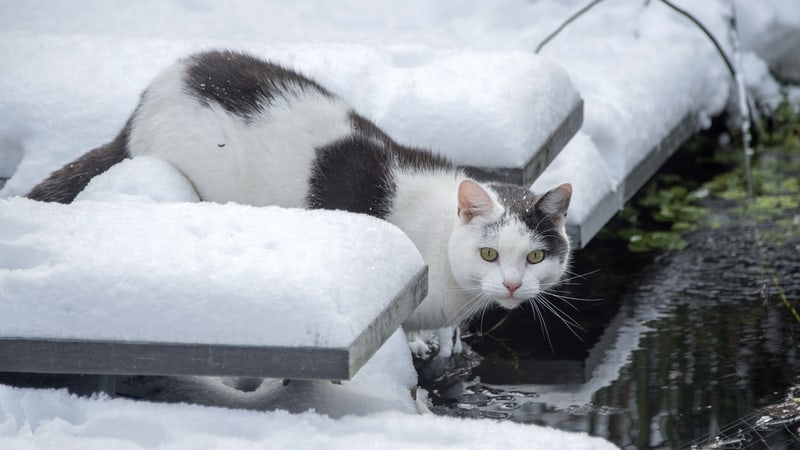How to Build a Winter Cat Shelter
An animal advisor weighs in on shelters and tear stains

Animal lovers’ hearts break seeing stray cats roaming the neighborhood in foul weather. In this edition of “My Pet World,” pet advisor Cathy M. Rosenthal offers instructions for creating a winter cat shelter to a woman who is worried about her informally adopted outdoor cat.
Dear Cathy,
I have an outdoor cat who “adopted” us six months ago. She appears to be a year old. I feed “Tiger Lilly” twice a day and provide fresh water. She always comes when she hears my voice and even allows me to brush and groom her. The tip of her right ear has been cut off, indicating she’s part of the “Catch and Release” program here in Las Vegas. I understand that a fixed cat doesn’t (or is less likely) to spray territory. Correct?
I want to provide a bed or winter cat shelter to protect her from the elements. The problem is, there are other stray cats in the neighborhood, and they’ve already sprayed several areas around my property. How can I provide shelter for her, but keep other neighborhood cats from spraying it?
– Bernadette Las Vegas, Nevada
Dear Bernadette,
You’re correct; cats spray to mark their territories for mating. Overall, if they are fixed, they should be less motivated to spray, but 10% of males and 5% of female cats may still spray after being sterilized. The best thing would be for all the cats in the neighborhood to be fixed through the city’s “Catch and Release” program. This not only prevents unwanted kittens but reduces feline mating behaviors, like fighting and spraying.
As for the outdoor winter cat shelter, it’s great you want to provide one for her. Unfortunately, there is no guarantee she will be the one to use it if there are other cats around. If you place it in an area of your yard where you brush her, you may improve the chances she will use it since she will know it’s there. You also could try to train her by calling her over to it (since she comes to your voice) and giving her a treat or tossing a few treats inside it to get her to explore.
If you’re willing, the best thing to do would be to make several cat shelters to increase the odds she will have access to at least one. You can make them out of insulated Rubbermaid bins or Styrofoam coolers. Cut a 5½ to 6-inch hole several inches off the ground to keep rain and snow from getting inside. Cut the same-sized hole in the back, so she will have an escape route in case a predator tries to enter. Put a flap on the doors for additional warmth and cut it vertically every 1½ to 2 inches up to about 1 to 2 inches from the top to ensure she can get in and out. Drill a few holes in the bottom to allow moisture to drain out of it. Finally, layer it with a few inches of straw (not hay) to keep the bedding dry. Then look for a protected area to place it, away from north winds, dogs, and the interference of people. Place a rock or brick on top of the container to keep the wind from blowing it over or away.
If you are a visual person, you can find step-by-step instructional videos on how to make a winter cat shelter online.
Dear Cathy,
I wrote to you last year about my white dog with red tear stains. I tried several products, but nothing worked. While visiting a friend, my dog started eating her cat’s dry food. My dog is a picky eater, so I was surprised. My friend said it was salmon-flavored pet food.
I searched and found a limited-ingredient diet with salmon, and she loves it. The bonus is the red stains disappeared. I don’t know if this will help anyone else, but my little dog is much happier now that she enjoys her food and looks beautiful. I guess you have to keep trying until you find what works.
Lois, Glen Cove, New York
Dear Lois,
That’s wonderful news, and it can’t hurt for someone else to try a limited-ingredient diet with their dog to see if it helps with eye staining.
Pet food manufacturers developed limited-ingredient diets to address pet food allergies. These diets offer a single protein and carbohydrate source (like salmon and sweet potato, for example), a few supplements, and some fats to provide a healthy and hopefully allergy-free diet for the dog or cat. Even though it says “limited ingredients” on the label, it is not regulated by the FDA. So, for others (not you, because you found what works), check the pet food label to ensure only a few ingredients are listed compared to other pet foods.
Thanks for sharing what worked for your dog.
Cathy M. Rosenthal is a longtime animal advocate, author, columnist, and pet expert who has more than 25 years in the animal welfare field. She addresses reader questions as diverse as outdoor cat safety to bizarre dog behavior. Send your pet questions, stories, and tips to cathy@petpundit.com. Please include your name, city, and state. You can follow her @cathymrosenthal.
© Tribune Content Agency, LLC


